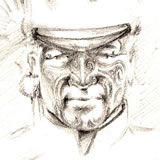See historic events for any day of the year by entering the date below. Why not try your birthday?
What happened that day?
Kiwi of the Week
Moka Te Kainga-mataa
Moka, as he was originally known, was the youngest of three brothers, all influential Nga Puhi chiefs. Following the battle of Te Ika-A-Ranganui at Kaiwaka in 1825 (where he was shot but rescued by fellow Nga Puhi chief Rawiri Taiwhanga), he took the name Te Kainga-mataa - meaning either 'Wounded by a bullet' or 'The holder of ammunition'.
Originally of the Ngai Tawake hapu, from Okuratope Pa, Waimate North, Moka and his brothers, Te Wharerahi and Rewa, later formed the Patukeha hapu, in memory of their mother who had been slain by a Ngare Raumati taua in 1800.
Moka was one of Hongi Hika's generals and a distinguished warrior during the Musket Wars. He participated in a number of battles, including Matakitaki, Mokoia, Te Totara, Kaiwaka and Urewera.
Moka and his two brothers were original signatories to the Declaration of Independence, signed by a number of Northern chiefs at Waitangi on 28 October 1835. He was also present at Christ Church, Kororareka (Russell), on 30 January 1840, when Captain William Hobson read proclamations extending the boundaries of New South Wales to include the islands of New Zealand, confirming Hobson's own appointment as Lieutenant-Governor, and dealing with the issue of land transactions (notably pre-emption). At the completion of this event, a document stating what had occurred was signed by around 51 people - Moka was the sole Maori signatory.
On 5 February 1840, at Waitangi, Moka and his brother Rewa both spoke against the proposed Treaty with the Crown. Moka raised the issue of illegal land transactions by certain Europeans, and referred to the proclamations of 30 January. He said,
Let the Governor return to his own country: let us remain as we were. Let my lands be returned to me - all of them - those that are gone with Baker. Do not say, 'The lands will be returned to you.' Who will listen to thee, O Governor? Who will obey thee? Where is Clendon? Where is Mair? Gone to buy our land notwithstanding the book [proclamation] of the Governor.
Hobson was reminded of discussions at Kororareka the week before, where he had promised 'that all lands unjustly held would be returned; and that all claims to lands, however purchased, after the date of the Proclamation would not be held to be lawful.' Moka immediately challenged Hobson's claim: 'That is good, O Governor! That is straight. But stay, let me see ... Where is Baker? Where is the fellow? Ah, there he is - there standing! Come return to me my lands.' Baker quietly replied, ‘E Hoki Koia' (‘Will it indeed return?'). Lacking an understanding of Maori, Hobson ignored this insult. Moka retorted: ‘There! Yes, that is as I said. No, no, no; all false, all false alike. The lands will not return to me.'
At this point, with other chiefs speaking of their wish to send the Pakeha away, the outlook appeared bleak for the Crown. Later in the meeting, though, Moka's elder brother, Te Wharerahi, supported the Crown and the Treaty. He was backed by influential Hokianga chiefs Tamati Waka Nene and his brother Eruera Maihi Patuone, whose views helped sway opinion. (Te Wharerahi, incidentally, was married to Nene and Patuone's sister, Tari.)
The following day, a number of chiefs signed the Treaty, including Te Wharerahi and - after much prompting - Rewa. But although Moka's name appears on the Treaty document (written as ‘Te Tohu O Moka'), there is no signature or mark on the document itself. It seems, then, that Moka chose not to sign as a matter of principle. He is thought to have died in the 1860s and is buried in the Paripari urupa (cemetery) at Mataraua.
This biography was written by Brent Kerehona.
The drawing of Moka Te Kainga-mataa is by Natanahira Pona, 2007.





